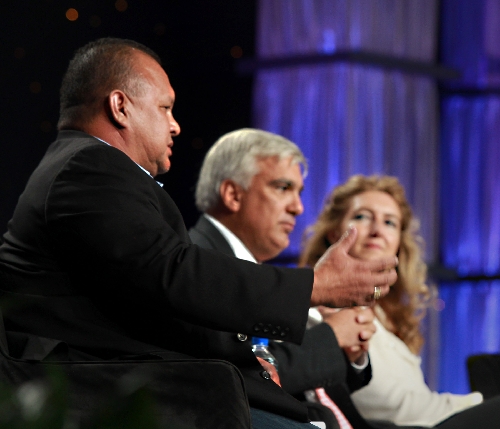G2E 2012: Tribal gaming execs mark regulatory act’s 25th anniversary
The evolution of tribal gaming in the two decades since the passage of the Indian Gaming Regulatory Act is obvious. Multimillion-dollar resorts dot the landscape in many states, replacing the original bingo halls housed in run-down trailers.
Jana McKeag, president of Lowry Strategies, an Alexandria, Va.-based government and public affairs consulting firm, said the act "changed Indian country forever." The federal law approved by Congress in 1988 established the jurisdictional framework that governs tribal gaming.
The act will turn 25 in October 2013.
"That time has flown by," Tony Sanchez Jr., president of the Seminole Tribe of Florida, said Thursday during a panel discussion at Global Gaming Expo at The Venetian.
The three-day Global Gaming Expo ended Thursday.
Sanchez said it has been a quick 25 years in which the Seminole Tribe have gone from operating bingo halls to building Las Vegas-style casinos and owning the Hard Rock name.
"We see opportunity both domestic and international with the Hard Rock brand," he said. "The gaming business will continue to evolve. With technology evolving, we are always looking at how we can incorporate it into our existing business."
Sanchez joined National Indian Gaming Association Executive Director Jason Giles, Gaming Laboratories International President and CEO James Maida and Katherine Spilde, chairwoman of the Sycuan Institute of Tribal Gaming at San Diego State, in a panel discussion on the act's forthcoming 25th anniversary and its effect on the tribal gaming business.
Maida, an attorney, opened the first nonstate independent gaming testing lab in his garage in the late 1980s. He said the first state compact in 1988 in Minnesota was 11 pages and remains the backbone of the tribal gaming business today in the state.
"Six weeks later, I got a call we were off to Madison, Wis., to negotiate another compact," Maida said. "Today, there are 228 tribes and 265 casinos that work with Gaming Laboratories International."
When asked whether he thought tribal gaming would be as successful as it is, Maida told some 200 industry executives and analysts, "I didn't know ... nobody could have known."
Giles attributed tribal gaming's success to "strong regulation" of its casinos.
"That is the backbone," Giles said. "Tribal leaders originally didn't want IGRA. It was very restrictive. But 25 years is just a short history. We are just scratching the surface."
He also said tribal casinos survived the recession in better shape than commercial casinos. Giles said a number of tribal casinos struggled, but avoided the massive layoffs the commercial casino industry had.
"Tribal gaming is different, it's about protecting the community," Giles said.
The act was created to provide a legislative basis for the operation and regulation of tribal gaming, to protect gaming as a means of generating revenue for the tribes and to encourage economic development.
The law also established the National Indian Gaming Commission to regulate the industry, while the U.S. Department of the Interior also has an oversight role.
Lowery Strategies' McKeag concluded the hourlong panel discussion by asking where the industry was going in terms of advances in technology.
"I-gaming is an issue that is going to arrive in some form and some way," Maida said.
He said some compacts are 20 years old and it will be difficult to update them to deal with online gaming. Maida said the industry was considering "how to amend them for technology with out opening them up again" for negotiations.
"We have been dragging our feet to understand how we are going to enter this market," Sanchez said. "We know we want to be in that market. We are not in a big hurry at this point. We are waiting."
Contact reporter Chris Sieroty at
csieroty@reviewjournal.com or 702-477-3893.
Follow him on Twitter @sierotyfeatures.






















